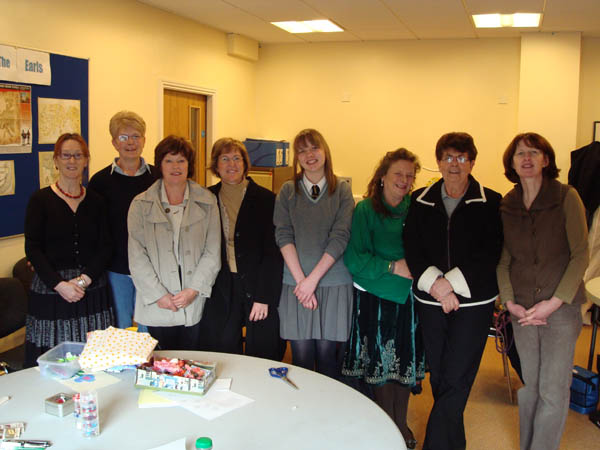Event Details

Participants delighted with their achievement at the workshop ”Niaeve Applique Sue and Sam Panel”, 10th April 2008, facilitated by Mary Good. (Photo: Alba Sanfeliu) |
| Workshop: | The Art of Survival: International and Irish Quilts - Workshops (5) |
| Description: | As part of the exhibition programme a series of four half-day workshops (8th - 11th April 2008) took place at the Tower Museum and one workshop "The Politics of Chilean arpilleras" was held in the Harbour Museum,on 11th April. The workshops at the Tower Museum are detailed below.
1)“The Quaker Tapestry: learn the secrets behind the stitches”, 8th April, facilitated by Bridget Guest.
Bridget explained how the tapestry panels were designed and created by over 4,000 people, and how these techniques continue to inspire others to create their own embroidery projects. The unique Quaker Stitch was invented for the Quaker Tapestry project. The main aim of this workshop was to learn the technique of this versatile stitch and practice it. Materials were provided
2)“Draw, design and make with flowers: a contemporary flower paper quilt”, 9th April, facilitated by Doris Rohr (Artist/Lecturer Art & Design, University of Ulster)
This workshop, attended by 7 participants, explored the emotive power of flowers as a source for drawing, painting, collage, textile art or other art processes. Participants were asked to bring a flower or a plant (cut or in a pot) particularly those which had a special significance, which the women would be willing to share with the other participants. Basic materials were provided. Some participants preferred working with their own materials; others contributed materials to the workshop.
Workshop photographs
3)”Niaeve Applique Sue and Sam Panel”, 10th April, facilitated by Mary Good
In this workshop women were shown how to use this technique to make a cushion or small tablemat. They brought embroidery needle, scissors and pencil. A 12” square of fabric for the background and a small piece of bondaweb was provided in class at a small charge to the participants. The participants were asked to bring along any small pieces of coloured fabric to use for the appliqué and these were shared out among all other class members. Embroidery thread was provided.
Workshop photographs
4)”Celtic Animal Designs”, 11th April, facilitated by Irene MacWilliam
The participants, 10 in total, painted a Celtic animal design and transferred it to fabric. Irene discussed with the women how these could be used to make a small wall hanging, a bag, a greeting card, a tablemat or used in a cushion. No previous experience was required. Participants did not go home with a finished piece. Materials and designs were supplied.
Workshop photographs
|
| Commissioned by: | Derry City Council, Heritage & Museum Service with local partner |
| Date(s): | 8th April 2008 - 11th April 2008 |
| Venue: | Tower Museum, Derry / Londonderry, Northern Ireland
Union Hall Place, Derry / Londonderry, Northern Ireland. BT48 6LU |
| Curator: | Roberta Bacic |
| Facilitator: | Each workshop was lead by a different tutor/facilitator |
| Outcome: | The following statement by Margaret Edwards, Education Officer with the Heritage and Museum Service captures the outcomes.
"The Art of Survival Exhibition 'Workshop Week' was a great success for the Heritage and Museum Service. We welcomed a wide range of new visitors to the Tower Museum and as made a number of new connections. The workshops were aimed at adults and everyone who took part commented on how much fun they had as well as learning some new techniques and meeting up with old and new friends.
We also ran an activity for schools, facilitated by Louise McElhinney. Ten pupils from Lisnagelvin and ten from Steelstown Primary Schools, over four mornings at the Workhouse Museum, produced their own wall hanging which then went on display in the Tower Museum.
The nature of the exhibition was very interactive and therefore the workshops were designed to allow the participants to work with textiles, to work with each other and to get a better understanding of how quilts have been used over centuries to record events and happenings as well as providing an alternative form of expression."
|
|